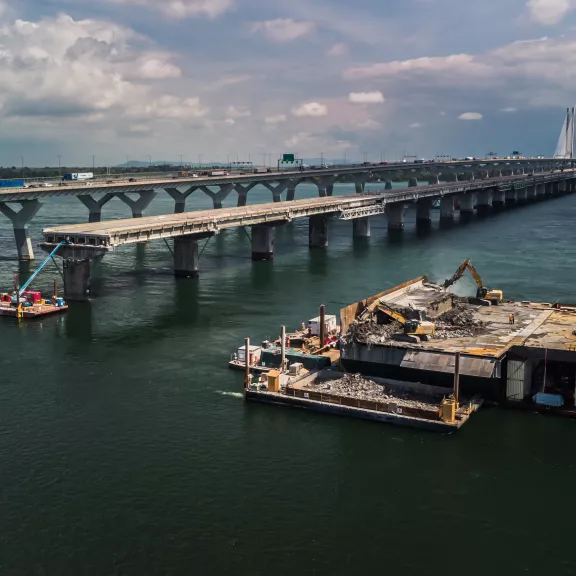

In light of an agreement with Jacques Cartier and Champlain Bridges Incorporated (The Corporation), Nouvel Horizon Saint-Laurent (NHSL) has been tasked with quantifying greenhouse gas (GHG) emissions related to the deconstruction of Champlain Bridge. To do so, a GHG inventory specific to the project’s organizational and operational boundaries was created. The objective of the inventory is to track and record emissions generated by NHSL and its contractors during construction activities, including the dismantling of the bridge’s spans, deck, piers, and metal structures, and the work associated with the construction of three temporary jetties. The works noted above fall under the three scopes of GHG emissions commonly referred to as Scope 1, 2, and 3, detailed below.
Scope 1 includes all direct emissions controlled by and linked to NHSL activities, namely the fuel used to power machinery, watercraft, fixed and mobile equipment, and vehicles. Scope 2 consists of indirect emissions associated to the purchase of energy (electricity, steam, heating, cooling) from a third party by NHSL. Although scope 2 emissions physically occur at the facility where they are generated, they are accounted for in the inventory because they are a result NHSL’s energy consumption. In this case, tracked emissions are those generated from purchased electricity from the public grid. Lastly, scope 3 emissions accounts for employee travel to-and-from their residence and project site and offices in addition to fuel consumed by third party transportation suppliers outside of NHSL’s control.
Effective upfront planning was needed to ensure that the GHG emissions were properly accounted for. Evaluation reports will be produced based a predetermined schedule during the project’s 43-monthlifecycle. Initial reports identifying all major project-related emissions will be produced after the first 120 and 240 days, followed by annual reports. Systematically identifying all sources of emissions is a key element in the planning process. As such, several members of the project team were assigned responsibility for collecting and recording data from individual emission sources. Once collected, emissions records are then transmitted to the GHG Accounting Coordinator who is responsible for cumulating emissions data. The resulting information is then forwarded to the person responsible for quantifying emissions who prepares and drafts the final emissions report. The final reports are then verified by a third party and submitted to The Corporation. These steps involve many people, services, and several thousand lines of data, hence the importance of tedious preparation and strong communication!
